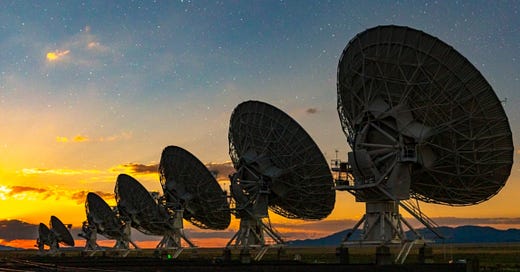Summer blockbuster Part Three: Is anyone out there?
Space aliens abound in Hollywood. Will we ever contact any in reality?
August is upon us and summer winding down, so the All Predictions Wrong Summer Blockbuster Series concludes with Part Three. Parts One and Two had some fun with sci-fi space aliens. Part Three asks – what does science tells us about the chance of actual other civilizations?
Last year the great Yale historian Timothy Snyder asked why the Milky Way galaxy – about 100,000 light years across, containing at least hundreds of billions of worlds -- appears devoid of intelligent life trying to contact us.
.A half century of SETI – Search for Extraterrestrial Intelligence – has come up with nada. I summed the search, and its frustrations, in The Atlantic. Published 1988, when I was living in Pakistan, that essay reads well today.
The Very Large Array, radio telescopes near Magdalena, New Mexico. Photo courtesy National Radio Astronomy Observatory.
The one aspect that’s changed is that at the time, no planet beyond our solar system – no “exoplanet” -- had been discovered.
Telescopes have improved quite a bit. A Substack on the Golden Age of Telescopes is in the works, probably to run after the election.
As I compose this sentence the exoplanet count is up to 5,741, a tally that may rise while you read the sentence. The latest discovery is the gas giant TOI-3919b.
TOI-3919b is about 2,000 light years away, which might as well be infinity. At the speed of the fastest manmade object, NASA’s Parker Solar Probe, it would take a million years to reach TOI-3919b. Unless some kind of faster-than-light drive is invented – so far science says this is impossible, but two centuries ago, science would have called the Apollo mission impossible – almost all the galaxy always will be inexpressibly distant.
Keep reading with a 7-day free trial
Subscribe to All Predictions Wrong to keep reading this post and get 7 days of free access to the full post archives.





